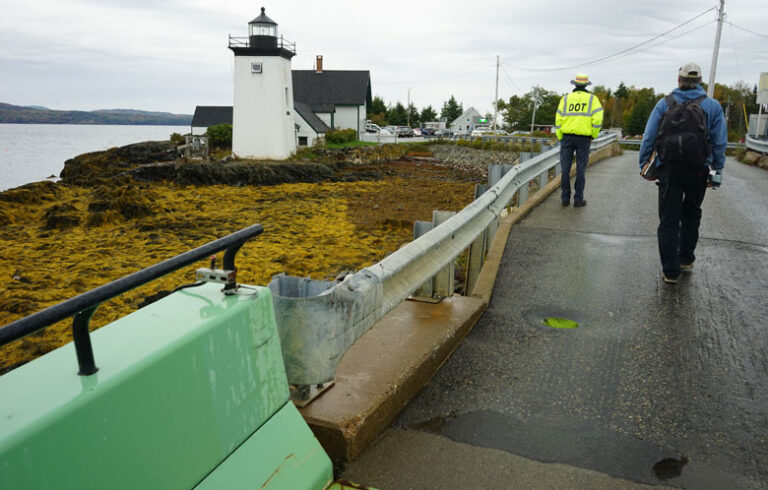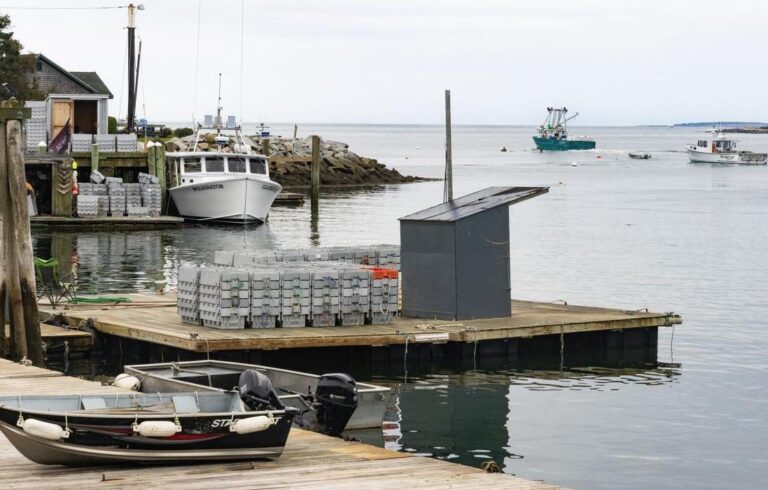By Stephanie Bouchard
Ecological artist Krisanne Baker of Waldoboro focuses much of her art work on water, so she spends a lot of time in and around it, but one night a couple of years ago really blew her away.
She’d been working in a hot glassblowing studio. When she finally wrapped up, she made her way to the water and slipped into the refreshing coolness of the ocean. In the liquid darkness, she saw quite a sight underwater: glowing phytoplankton—tiny organisms in the water that ocean scientists will tell you are the basis of life.
“It made me curious,” she recalled to an audience at Bigelow Laboratory for Ocean Sciences in East Boothbay in July. “It was a moment of wonder. I think that’s one of the things we have in common as artists and scientists: that we’re inspired by this wonder and we’re curious about it and want to know more.”
Baker was speaking to a crowd of about 300 people at the first of Bigelow’s annual summer lecture series, Café Sci, which is a free series open to the public that shares information about ocean research.
Usually, the presentations are straight-up science talks by researchers, but this particular presentation was different—it revealed the connection between art and science and the lab’s long collaboration with artists by showing the audience some of the recent and upcoming art projects being created with the lab’s scientists.
Among the art projects showcased was Baker’s vertical glass sculpture hanging from the ceiling in the entry hall of Bigelow’s main building on its East Boothbay campus. Made from more than 100 pieces of glass and other materials (including test tubes and pipettes from the lab), the sculpture captures the algae and phytoplankton she observed through a microscope in the lab’s National Center for Marine Algae and Microbiota, where she worked with the center’s director, Mike Lomas, a biogeochemist. Some of the pieces are infused with non-radioactive strontium aluminate so that they glow in the dark like some phytoplankton do.
Other art projects featured in the presentation included a performance by Maine-based Halcyon String Quartet, which paired music with images showcasing life and work in the Gulf of Maine; a video of iron-oxidizing bacteria in the Arctic shot by Boothbay artist Philippe Villard and narrated live by Bigelow researcher David Emerson; and a preview of Anna Dibble’s eco-art project.
Working with Nick Record, a research scientist at Bigelow, Brunswick-based Dibble is orchestrating an art installation reflecting the impacts of climate change on the Gulf of Maine. The installation is a work-in-progress collaboration drawing on the talents and know-how of professional artists, scientists and local students. It is due to be installed at Bigelow in the summer of 2021.
Bigelow has been partnering with artists for two decades. Many of the projects are self-funded by the artists, but others have received support from research grants and private donations, said Steven Profaizer, Bigelow’s director of communications.
Bigelow collaborates with artists as a way to make science understandable. “We study stuff you can’t see,” said Deborah Bronk, Bigelow’s president and CEO, in her introduction to the Café Sci program. “It’s a challenging thing, trying to get people to care about something you can’t see.”
And that’s where art comes in. It can make the invisible, visible, and the difficult-to-comprehend, understandable, and even relatable.
To learn more about Bigelow’s Café Sci series, and watch videos of the presentations, go to visit www.bigelow.org/news/cafe-sci.html.





